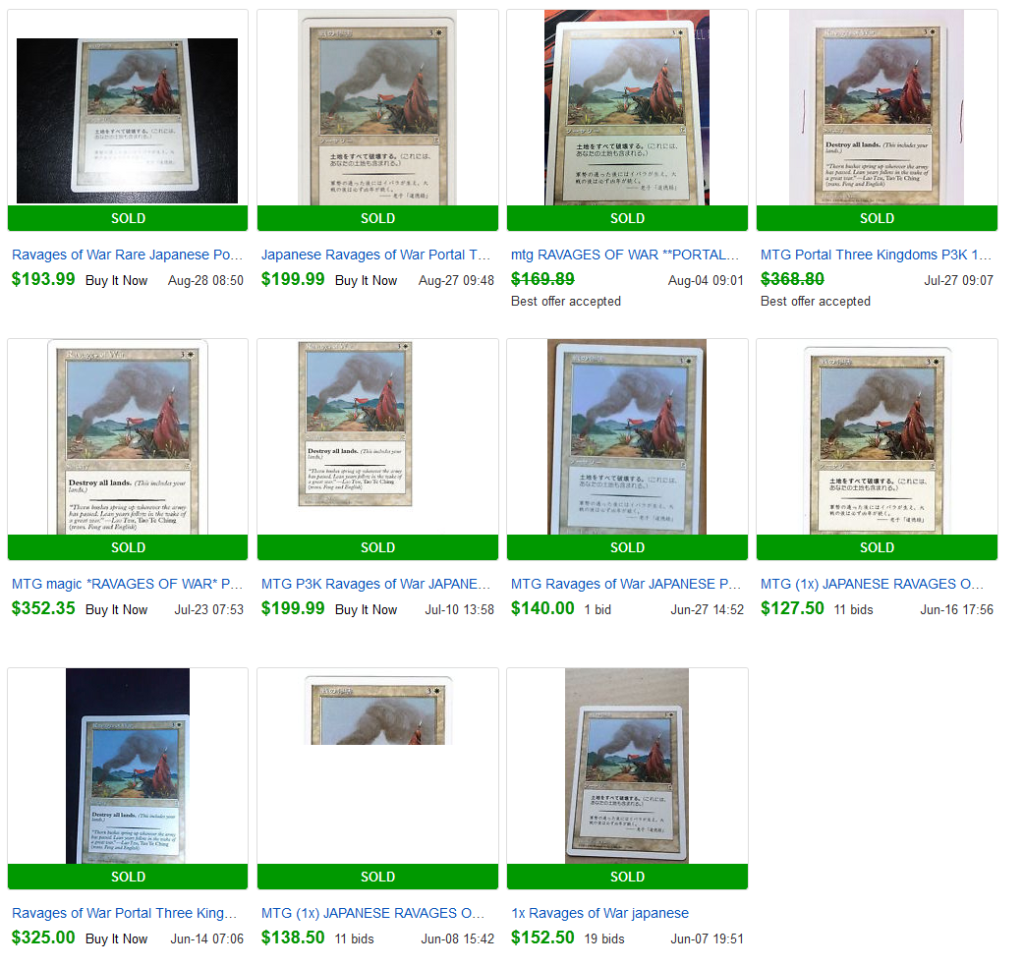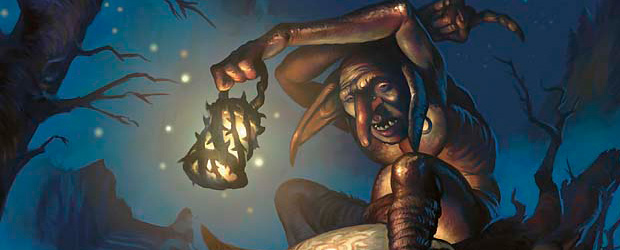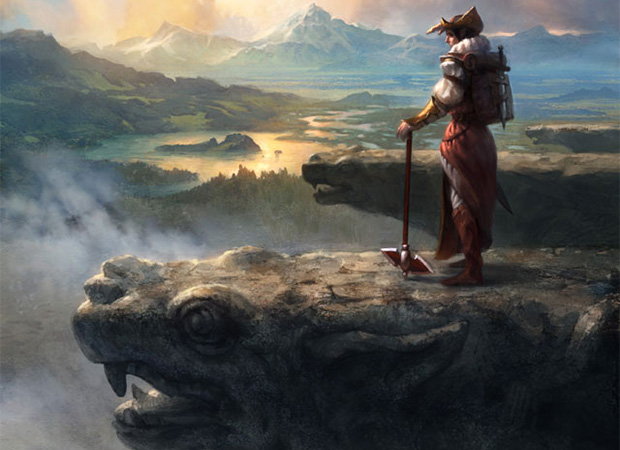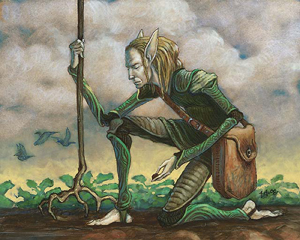By: Travis Allen
This summer has been a particularly quiet one for those of us into the Magic market. I haven’t gone digging through my bulk rare box for spikes once, none of the stuff in my spec box has moved, and Modern prices have stayed flat. Overall it’s been real boring for most of us, and everyone has been looking forward to the fall for some exciting changes.
Boy are we getting them.
Unforeseen Consequences
First off, read this article. Read every word on the page. Do it twice if you have to. It’s probably the most important words about Magic that have been written and will be written this year. (This entire article assumes you’ve read that one.)
I’m going to stick these here so that we can keep staring at them while trying to grasp what is happening.


This is clearly a massive change to the game. Not only will this affect things on the surface, such as length of format legality, card availability, and format demands, it will have smaller, quieter effects as well, such as design and development decisions, manabase concerns, and reprint ramifications. We won’t fully be living in the new world until the fall of 2016 which means it’s going to take years before we fully appreciate the impact this is going to have on the game and markets. We’re not the only ones that have to wait awhile to see how it all plays out either. Wizards will be watching closely, and like all major changes they roll out, expect some tweaking to the system after a few million players push it from every direction.
Given how long it’s going to take to fully get into the swing of the new system, along with the likelihood of Wizards making some additional changes along the way, we won’t really know how the markets will react for years. Myself and plenty of others will be making some educated guesses over the coming weeks and months, but I don’t doubt there will be plenty of fallout that will be nearly impossible to see from here. For instance, as I mentioned at the start of the article, typically the summer months have a drought of interesting market movement. Will a brand new block hitting in May change that entirely, or are people truly tied to the game seasonally rather than by a set release schedule? There’s no way to know for sure until we get to that point.
Another major unknown will be the way inference and speculation is conducted. Right now, everyone making decisions based on educated guesses about the future leans heavily on the known block model. For instance, take Ravnica block. Once we knew that we were going to be returning to Ravnica back in early 2012, you could make a fair assumption that shocklands would be in the block. If that was true, then the next leap was that the fetchlands wouldn’t be printed in Standard until at the earliest fall of 2014. Why? You quite reasonably figured it unlikely Wizards would print fetches and shocks alongside each other in Standard. Knowing that shocks would be in the upcoming Ravnica block in the fall of ‘12, it was clear then that fetches couldn’t be printed in the expansion the following fall, meaning that the earliest you could see them was fall of ‘14. For a sense of scale, this means that back when Delver of Secrets and Green Sun’s Zenith were legal you could have predicted the earliest date at which fetches would be printed again was two and a half years away. Knowing that, you could make trades and buys feeling confident that there wouldn’t be a major printing of the cards anytime soon. All of that information was derived simply from a thorough understanding of how the block structure worked, as well as experience with how Wizards treats Standard.
Those same types of logical inferences will be available to us eventually, but it’s going to take some time to figure out. For instance, is Wizards going to put a rare land cycle in every block? That would mean three big land cycles would be in Standard at any given time, which is a lot of mana. Are they going to do every other block? How are they going to approach flavor-specific reprints, such as Urborg, Tomb to Yawgmoth? What about cards whose power level they’re concerned with? In the past, some of the most dangerous cards are printed in the spring set because they have the least amount of time to potentially ruin Standard. That won’t really be a method of controlling overpowered cards anymore, since everything will be legal for roughly the same amount of time.
A great deal of information we use to make informed purchases and sales on a daily basis comes from understanding the block rotation model and what Wizards is willing to print where. With this major change that’s all getting turned on its head. Our ability to confidently make predictions about what will and won’t happen is going to be hampered for quite some time.
Moving on, let’s take a closer look at those animated rotation models to see what we can glean.
Conveyor Belt
Under the old system, there was a rotation every four sets that happened once a year in the fall. From fall to fall, the number of sets legal would slowly grow. Standard was at it’s smallest immediately after a fall set was released and at it’s largest immediately after a core set came out. (We’re currently in the largest Standard format.) 
This system meant that with each set released there was less and less of a chance it would have a major impact on the format. When Khans releases there will be a giant Standard shakeup, but that’s more of a product of Return to Ravnica leaving rather than Khans being added to the pool. As Louie and Dewey are respectively added to Standard, they are mathematically less and less likely to affect major changes. Because the Standard card pool keeps adding cards without removing them, the power level continues to rise and it becomes more and more difficult for new cards to have an impact. This effect is more pronounced in Modern, Legacy, and Vintage, where very few sets add more than a card or two to those formats. All of this builds until the following fall, where half the format drops out and it’s a whole new ballgame again.
In the new block model things are going to happen much faster. There will now be major format changes every other set. Twice a year, both in the fall and in the spring, a third of the format is going to disappear. With that many cards dropping away, established decks are going to lose huge chunks of their constituent parts. Even if any one particular deck doesn’t lose much itself, the loss of some particular predator may allow another deck to spring up that was not viable previously. For instance, when Good Jace was originally printed, it was alongside both Bloodbraid Elf and Blightning. Jace was mostly weak in that format because those two cards did such a great job punishing him. Once Alara rotated and took BBE and Blightning with it, Jace suddenly sprang into power because the cards keeping him in check disappeared. (Also other good blue cards were printed.)
We’re going to end up seeing faster, more dramatic cycles on a more regular basis. Every other set some several hundred cards will rotate and suddenly lose a large portion of value, and some previously underused gems are going to spring to the top of the heap. When Block D comes out, not only will it introduce a whole slew of new cards, but Block A will fall away. The cards in Block B and C, previously influenced by Block A, will now be viewed in an entire new light.
Some particularly great sweeper in Block A may have supported an entire control deck made mostly of cards from Block B and C. When Block A rotates, that control deck is suddenly going to be missing a key component. Meanwhile, a great aggro deck hiding in Blocks B and C that was waiting for control to wane will become viable. The financial implications of this are pretty clear. That control deck is going to have wild price swings on not only the sweeper that rotates out of the format, but also all the other cards that relied on it. Meanwhile, those aggro sleepers are going to jump once the deck becomes tier one. All of this is happening with cards in Blocks A, B, and C, even though it’s Block D that just released.
Constant changes to the card pool are going to mean constant changes to card values. Format pillars will lose support and drop appropriately, while powerful cards kept in check by existing metagames will jump once their predator is gone. The resulting market will be a constant cycle of large drop-offs and big gains. This is as much a double-edged sword as I could imagine.
On A Rail
Another factor to all of this is length of card legality. Here is how long each set of Return to Ravnica is legal in Standard:
Return to Ravnica: ~24 months (Oct ‘12 – Oct ‘14)
Gatecrash: ~20 months (Feb ‘13 – Oct ‘14)
Dragon’s Maze: ~17 months (May ‘13 – Oct ‘14)
Magic 2014: ~15 months (July ‘13 – Oct ‘14)
Now let’s see how long sets will be legal in the new Standard:
Blood: ~19 months (Oct ‘15 – May ‘17)
Sweat: ~15 months (Feb ‘16 – May ‘17)
A few things immediately jump out when we look at these durations. We no longer have to endure two whole years of Standard dominated by obscenely powerful cards such as Sphinx’s Revelation, Thoughtseize, or Shocklands.The most powerful cards will only hang around in Standard for roughly as long as the spring sets dol now. Think about how long Voice of Resurgence and Blood Baron have been in Standard – that will be the longest period cards are legal for. 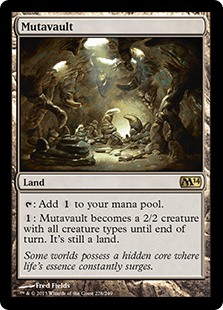
The second set will be shorter for even less amount of time, about what core sets are legal for now. Sweat releases in winter of 2016, which is historically around February. Think Gatecrash and Dark Ascension. It will be legal until the following year’s spring release, around the time Dragon’s Maze and Journey into Nyx release. Core set cards with a similar lifespan have been Mutavault and Thragtusk.
Summing all that up, nothing will be around as long as Revelation has been. The longest a card will exist in Standard is about how long we’ve had Voice right now, or how long Vengevine was legal. The shortest a card will exist for is just a bit over a year, such as how long Mutavault has been legal. The longest time period a card can exist is a good bit shorter than we’re used to, and the gap between the longest lasting cards and the shortest ones has been narrowed significantly.
The smoothing of the duration of legality is going to push towards more uniform prices on cards across sets. Because most cards will be legal for about as long as any other card, the concern that you won’t get to play with card A as long as card B won’t be too much of a worry. It was much easier to justify buying into Revelations or Thoughtseizes immediately after their release because they were clearly format-defining and would exist for what felt like forever. Voice of Resurgence, on the other hand, was a harder pill to swallow because you had so much less time to use it.
Similarly, there will be less imperative to purchase those key AAA cards. Don’t feel like investing in the hottest format staple revealed in Khans? Don’t sweat it as much. It’s not going to be around nearly as long as it would have been without the change. Eighteen months isn’t exactly a short period of time, but it’s half-a-year less than it would have been. You also won’t see cards ruining formats in tandem nearly as much. If two cards together are format-warping (think Splinter Twin and Deceiver Exarch) and are from two different sets, they’ll be spending less time legal together than they would have. In addition to this, rapid format changes means that what is a format pillar today may not be a few months from now.
Interloper
The draft formats, just like format legality, are getting a good shake up as well. One thing that’s up in the air is what the draft format will look like in two years. For instance, Theros was a “traditional” draft model with a 6:2:1 ratio. An average Theros card is roughly six times less rare than an average Journey into Nyx card, not adjusting for set sizes. I can’t imagine the price on Thoughtseize if it was printed in Journey rather than Theros.
The upcoming Khans of Tarkir set will be a bit different, with the three draft formats looking like this: KTK/KTK/KTK, Dewey/KTK/KTK, Louie/Louie/Dewey. Here we see a 5:2:2 ratio that should close the gap a bit on the distribution between the first set and the rest of the block. Cards in Khans will be more available than the other two blocks, but the difference will not be as drastic as between Theros and Journey into Nyx.
Beyond Khans is uncertainty. We can be reasonably confident that Blood and Sweat will be drafted together without Tears getting involved. Our estimation then is that the two draft formats for that block (and most typical blocks after that) will be Blood/Blood/Blood and Sweat/Blood/Blood. That creates an unfortunate 5:1 ratio, where for every five packs of Blood opened, only one of Sweat will be, resulting in a similar distribution of rares as Theros to Journey into Nyx. That’s a severe disparity in the new Standard, so I’m wondering if we’ll see Wizards try and curb it somehow with a different draft model. Perhaps we’ll see Sweat/Sweat/Blood? That would bring the ratio to 2:1, which is a lot more balanced than 5:1. (Again, not adjusting for set size.) Obviously in a 5:1 ratio the prices on the small set can quickly grow to obscene levels while severely suppressing values on large set cards.
Hazard Course
Earlier I mentioned that the new block cycle is a double-edged sword. I say this because the new format is going to better reward those that pay attention and more severely punish those that don’t keep up.
Fall rotation is one of the most financially active periods of the game. Not only do all the cards exiting the format take a dump, you’ve got brand new cards hitting the scene with volatile prices and existing cards that couldn’t hack it in the old format get a new lease on life. Up until now, this has only happened once a year. Now that rotation will be happening twice, there will be twice as much time that prices will be correcting to meet the demands of the new format.
If you’re on the ball you’ll be moving your rotating staples ahead of the game, just as you’ve been doing now. You’ll also be targeting cards that are undervalued in the current format but could break out in the new one. Doing well will necessitate paying just as much attention to what is leaving the format as what is entering. Paying attention to what is leaving also signals what cards to sell off even if they aren’t rotating. When a Sphinx’s Revelation type card is about to rotate you’ll want to move your control staples ahead of that date, even if they aren’t leaving along with it. 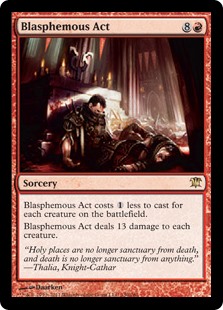
Individuals that don’t keep up are going to get hammered twice as hard. Those players are going to lose huge chunks of value in their collection not just once a year, but multiple times. With two rotations, that’s twice as many opportunities to hold onto staples too long and lose hundreds of dollars in virtual value as your Voices plummet. Not only will these players take a hit by holding onto rotating cards too long, they’ll also take a hit when they hold onto cards that while still legal, cease being major players in the format. The greater amount of turnover in Standard means that more often cards will fall by the wayside. We only have to look as far back as Boros Reckoner to see a perfect example. It was a huge player in the INN/RTR Standard because of the Aristocrats and Blasphemous Act. The rotation of most of the Aristocrats deck, along with the rise of Mono-Black, crushed Reckoner’s price. If you weren’t paying attention you lost a lot of money holding onto those Reckoners. (Meanwhile Lingering Souls, a card that kept both Nightveil Specter and Desecration Demon from being relevant, left the format and opened the doors for those two to terrorize the skies.)
Whether you’re paying attention or not, it will be more difficult to avoid sinking excessive disposable income into the game. Gone are the days where you’ll be able to build a tier one list in the fall then make small changes to it over the course of a year or two. The constant set cycling will be forcing you to make large changes to your decklist frequently, or even abandon the deck altogether, which means investing more money into the game more often.
There’s also the issue that your cards won’t be legal for as long as they were before. If cards are legal in Standard for less time overall, it means you have to refresh your collection more often to stay in the game. Over the course of maybe three or four years you’ll have refreshed your entire Standard binder once more than you would under the old system. There’s money in these more rapid changes, but again, only for those doing their homework to stay ahead of things.
One exciting aspect of all of this is that sleepers are far more likely to burst onto the scene. A card printed in Journey into Nyx is forced to live it’s entire Standard life alongside Thoughtseize. If that card can’t perform in a world with Thoughtseize then it’s never getting a fair shake. In the new system, a card two sets away from Thoughtseize gets time to shine without having to deal with the hateful card. A card printed in Sweat is never getting away from a card printed in Blood, but a card from Tears will have a chance to operate without either of those two sets in Standard, which it previously wouldn’t have had.
Not only will cards have less permanent housemates, the formats won’t be solved as often or for as long either. Even if the next Mono-Black gets figured out relatively quickly, it will only be six months at most before a major change. This is in contrast to the year or more it can take to lose oppressive decks in the current system. With formats in greater flux more often, there will be far more opportunities for brewers to take the world by storm. The next Battlefield Thaumaturge is going to be positioned much better two years from now than he would be today.
Apprehension
At the end of the day I think we see a smoothing of card prices a little bit overall, although the highs and lows are going to come faster, harder, and more often. Hopefully the amount of product opened for the first set of a block should be a bit more in line with how much gets opened for the second set. The rapid change of formats will cause more cards to rise and fall than they do now.
Overall, the average price of cards should mostly stay the same. We should roughly see the same amount of unique cards printed in 2016 as we see printed in 2014. Standard may feel more expensive though, since most individual cards aren’t legal as long as they are today. The greater flux of Standard prices may push some people away who are scared of losing money to the cycle. The flip side of that is that fewer players will be frustrated with decks such as Mono-Blue dominating the format for long periods of time, and are more likely to want to play Standard since the metagame won’t be nearly as stale.
Reading Twitter it seems like the reception to this is quite favorable. Nearly everyone I’ve heard from has been a fan of the change. More new formats means more exciting Magic, which is good for all involved. Some are a little peeved that it will be more expensive to keep up with Standard, which is a fair frustration. Not everyone wants to play the stock market just to keep up with FNM.
For you and I it’s definitely a good change overall. More turnover and more change means more opportunities to profit. Having said that, It will be a bit more challenging now for sure. We’ll have shorter timetables to work with, and it will take a little while before we figure out exactly where the best places on the calendar will be to buy which cards. I don’t believe we’ll know fully how the markets will handle all of this until we get there and start seeing what happens. If there’s one thing we certainly know at this point though, it’s that the future of Magic just got a lot more exciting.


